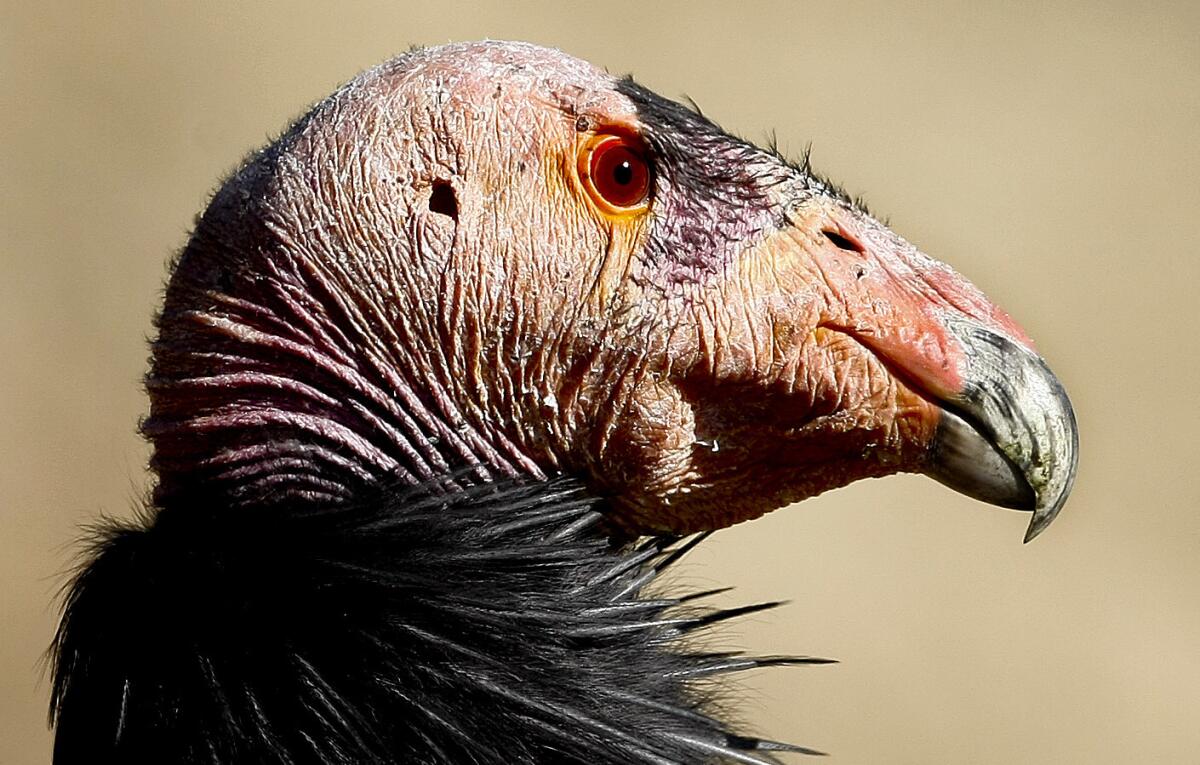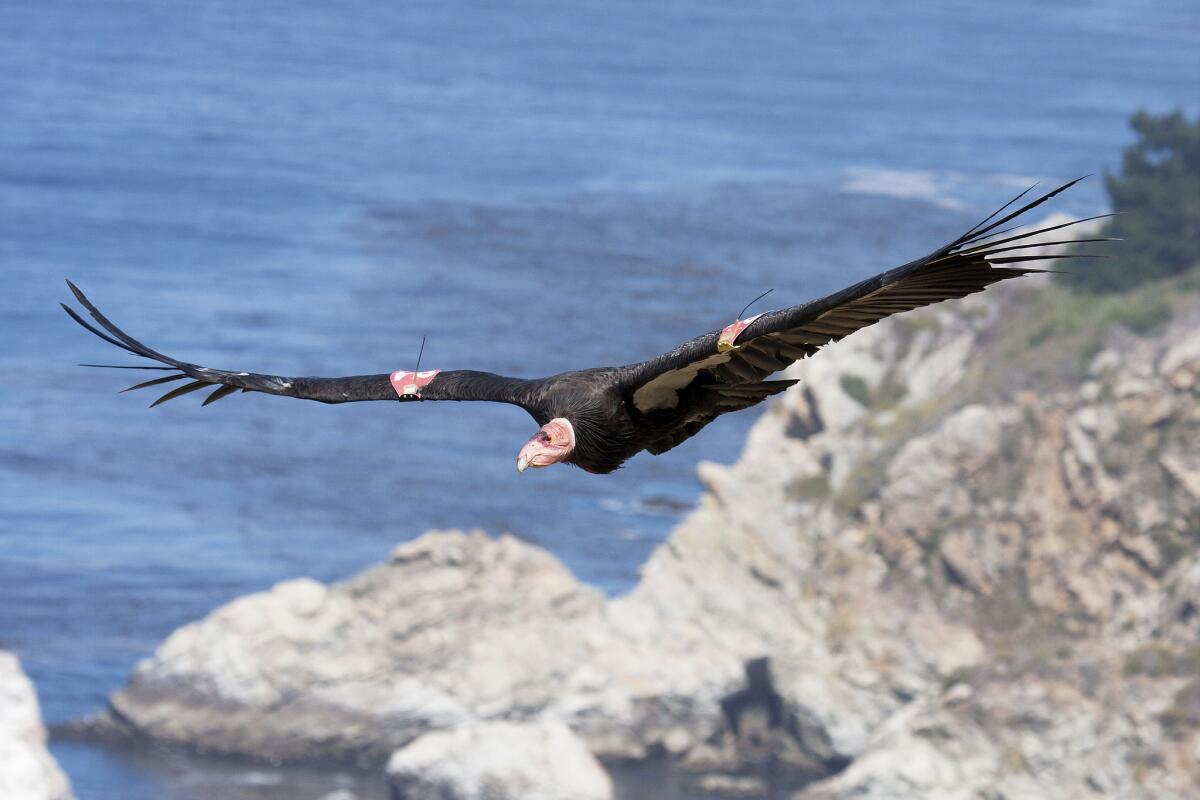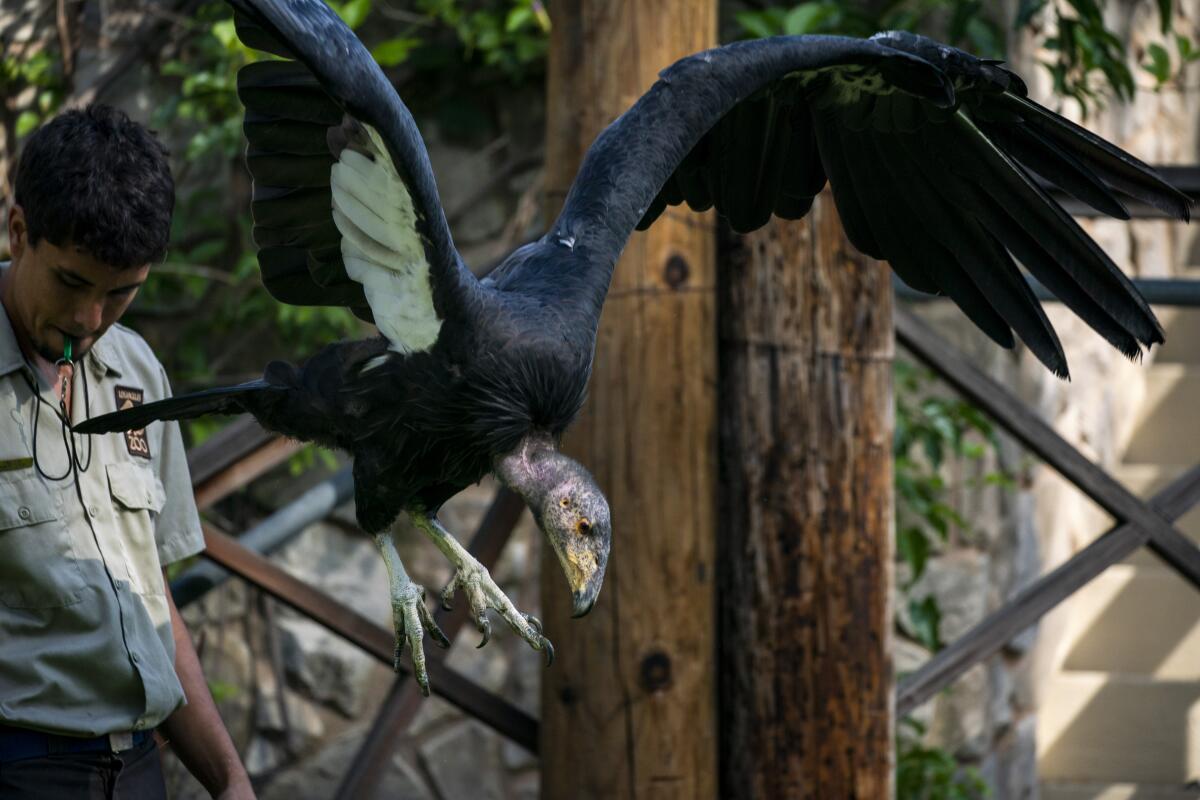Where to see California condors in the wild

- Share via
The California condor is the largest flying bird in North America, with wings that spread 9.5 feet tip to tip as it soars at speeds up to 50 mph thousands of feet above the earth. “Seeing a California condor in the wild is like seeing the Grand Canyon,” says Joseph Brandt, supervisory wildlife biologist of the state’s California Condor Recovery Program. “There’s a grandeur, a majesty about the experience that’s worthy of your bucket list.”

And this is the perfect time of year to see one in the wild.
In 1982, the chances of seeing a California condor, a.k.a. Gymnogyps californianus, in the wild were practically nil. This large vulture that in past centuries was found in many parts of the West had dwindled to 23 birds in the mountainous parts of Southern California. All that changed in 1987, after the remaining wild birds were captured and moved to the Los Angeles Zoo and the San Diego Wild Animal Park to embark on an experimental, species-saving, captive breeding program.
The gamble paid off. In July, the 1,000th condor chick was born in the wild, on the cliffs above Zion National Park in southeastern Utah. And there’s more good news: Wildlife experts expect condors to thrive on their own in a decade’s time. “A few conservationists argued that it was better to allow the last remaining condors to die in the wild with dignity than be put in a zoo,” says Mike Maxcy, the L.A. Zoo’s curator of birds. “I’m glad they were overruled.”
One of the main causes of the condors’ rapidly declining numbers was lead poisoning from bullets that hunters used to kill animals, whose remains these scavengers eat. (The state has since banned lead in ammunition.) California condors are still considered a critically endangered species by the International Union for Conservation of Nature.
Puppet condor moms
Today more than 300 California condors live in the wild and nearly 200 are in captive breeding programs. Wildlife biologists in L.A. and San Diego for more than three decades joined with a growing number of partners in the recovery program. They developed methods of breeding and raising condors in captivity and releasing them into the wild with great success.
“At first caretakers used hand puppets that looked like condors to feed captive-bred chicks so they wouldn’t identify with humans instead of birds,” Maxcy says. “Now most chicks are raised by their parents or foster parents.”
California condors lay only one egg every other year in the wild. To speed up egg production, Maxcy and his team removed eggs from the nests to hatch in an incubator. “Nine times out of 10, this motivated the breeding pair to lay another egg,” he says. “We doubled the number of condor eggs produced each year.”
The first captive-bred condors were released in the wild in 1992. “We’ve learned over the years that we need to acclimate the juvenile birds in a prerelease flight pen with an older mentor condor for approximately two years before setting them free,” says Maxcy. “Condors are a flock species. The young condors need to learn the pecking order from an older condor so they will know their place in a group feeding at a carcass, for example.”
“We hope that the reduction in lead poisoning and the natural growth of the California condor population in the wild will mean that in another 10 years, the species can exist on its own,” says Maxcy. “It will have taken the cooperation of several conservation-based institutions, hundreds of people and roughly $50 million, but the California Condor Recovery Program will prove that if humans want to save a species from extinction, it can be done.”
Where to see condors in the wild
Today, more than 300 California condors fly free in California, Arizona and Utah. If you want to see one, be prepared to seek out canyons or cliffs near one of the release sites between now and the end of October. “Condors often roost in canyons or on steep slopes where there will be an uplift of warm air during the day,” Brandt says. “Like a hang glider, they take off from there and forage far and wide for food.”
Condors are easy to identify because their wingspan is almost twice as wide as that of a turkey vulture, which also has a bald head and feeds on carrion. Condors glide smoothly, while turkey vultures wobble as they glide. Using binoculars, you might also spot a numbered wing tag and a radio transmitter on the condors’ wings.
Be patient. The condor’s range is 15,000 square miles — roughly the size of the state of Maryland — so it may take several tries. “But don’t let that keep you from trying for a bucket-list condor sighting!” Brandt says.
Here are places in California where condors fly.
Bitter Creek National Wildlife Refuge, Kern County
The refuge covers more than 14,000 acres in the Cuyama Valley in southwestern Kern County and is home to a California condor release site. It is closed to the public, but the Friends of California Condors Wild and Free, a nonprofit organization based in Ventura, conducts tours of the facility twice a year and welcomes volunteers the fourth Saturday of every month. Sign up for free membership at [email protected] and then register for work days, when you’ll be asked to help with brush management and repairs to the bunkhouses where interns who monitor the condors stay.
On Sept. 21, the organization will staff a condor information booth on Hudson Ranch Road, a public road that runs through the Bitter Creek Refuge between Maricopa and Pine Mountain Club. Visitors have a good chance of spotting condors there too. Info: friendsofcondors.org
Mt. Pinos-Frazier Park, Los Padres National Forest
Los Padres National Forest borders the Bitter Creek National Wildlife Refuge. Since the early 1990s, people have visited the condor observation site on the 8,831-foot summit of Mt. Pinos to spot birds that have expanded their range into the forest. “Condor fans would hang out in camping chairs, drink tequila and watch for condors even back when their chances of seeing them were slim,” says Maxcy. “Some of the old-timers still go up there now, and their chances are much better.” Info: bit.ly/lospadrescondors
Hopper Mountain National Wildlife Refuge, Fillmore area
Located in the mountainous terrain of eastern Ventura County, approximately four miles northeast of Fillmore, this 2,471-acre wildlife refuge hosts a field site for monitoring captive-bred California condors. It’s closed to the public, and there are no access roads. Your best chance of spotting a condor is to take a tour held twice a year or join a volunteer work party held twice a month; both are organized by Friends of California Condors Wild and Free. (Register at [email protected].) Info: bit.ly/hoppermountain
You can watch condors on Hopper Mountain’s live-streaming nest camera too.
Big Sur
The Ventana Wildlife Society, a partner in the California Condor Recovery Program, releases captive-bred condors in its Big Sur wildlife sanctuary. The nonprofit also provides free non-lead ammunition to hunters and ranchers in condor territory. The organization offers condor-sighting tours on most Sundays, weather permitting, from 10:30 a.m. to 12:30 p.m. Tour guides take visitors along Highway 1 and use radio telemetry to locate the birds. Cost: $75 per person. Sign up at the website. Of course, you may get lucky and spot condors riding thermal updrafts along the cliffs at Big Sur. Info: bit.ly/bigsurcondors
Pinnacles National Park, south of San Jose
Pinnacles is the only national park in California to serve as a release site for captive-bred California condors. A likely viewing spot is the ridge southeast of the campground on the Bench Trail near the visitors center. Condors might be seen soaring on the morning thermals along the ridge and roosting in trees in the evenings. There are spotting scopes to improve your chances of seeing one.
Another likely condor-spotting area is the High Peaks Trail. This 5½-mile trail traces a steep route through cliffs and volcanic spires. It’s a strenuous hike, so carry plenty of water. REI will lead a condor hike 9 a.m. to 1 p.m., Nov. 3, $119 for REI members; $139 for non-members. Info: bit.ly/pinnaclescondors
Los Angeles Zoo, Griffith Park

To see what condors look like up close, you can watch Hope, a captive-bred condor at the Los Angeles Zoo. The bird was not released into the wild because of an injured wing, but she flies in the zoo’s free World of Birds show at noon and 2:30 p.m. every day except Tuesday.
Zoo admission costs $22 for adults; $19 for seniors; $17 for children 2-12; free for children under 2.
Info: lazoo.org
More to Read
Sign up for The Wild
We’ll help you find the best places to hike, bike and run, as well as the perfect silent spots for meditation and yoga.
You may occasionally receive promotional content from the Los Angeles Times.










